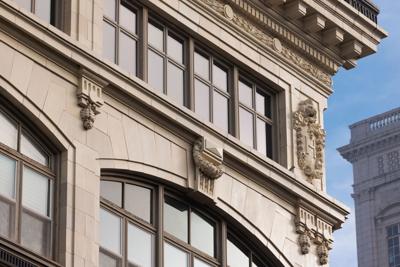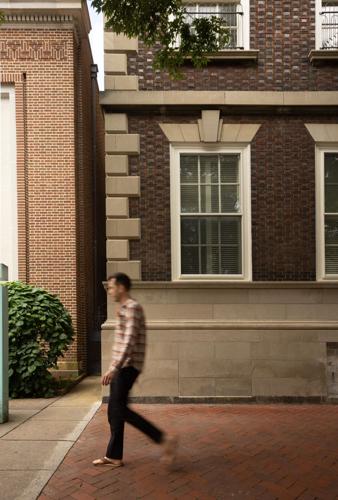ARCHITECTS’ ALPHABET, PART 11: K IS FOR KEYSTONE
The Architects’ Alphabet is a 26-part series describing design elements featured in Gregory J. Scott’s new book, “Urban Legend, The Life & Legacy of C. Emlen Urban,” Lancaster’s most renowned architect. Photos for the book, which is now available at egganddartbooks.com, are by Matthew Tennison
Imagine having the weight of the world on your shoulders — without any stress. That is the definition of a keystone. The keystone is the all-important wedge at the top of an arch that endures all the pressure imposed by its neighbors but is under no stress.
In 1802, Thomas Jefferson declared Pennsylvania the “keystone state” because of its geographic and economic position among the 13 original colonies. The fledgling leaders and colonials looked to Philadelphia for strength and guidance.
Although the use of a keystone in construction is traced back to 6,000 B.C., it was not until 312 B.C. that the ancient Romans recognized its ability to assist in the construction of aqueducts to span mountainous terrain.
How C. Emlen Urban used keystones in his Lancaster buildings [photos]
In design, the keystone is the all-important wedge at the top of an arch. It's used in a variety of design styles, used by architect C. Emlen Urban, around Lancaster. Here are some examples.
The keystone, or headstone, is one of three components that comprise an arch. The other two are the springer and the voussoir. The springer is the base of the arch and the voussoir are masonry wedges that lean equally into the wedge-shaped keystone, locking all pieces together.

The 1904 Fulton Opera House, now called the Fulton Theatre, is decorated in neoclassical style with a decorative painted keystone bearing fruit, bell flowers and nuts.
Because of their central and prominent position, the keystones are often carved and decorated with medallions, shields, animal masks or human likenesses that call attention to their importance. Keystones are prevalent in Georgian, Romanesque and Renaissance Revival styles of architecture. Interestingly, the keystone is also used in the construction of a “flat arch.” Although a bit of an oxymoron, the flat arch utilizes the same engineering principles as a round or “segmental” arch.
Neo-classical architecture is also rich with examples of keystones. Being a neo-classicist architect, C. Emlen Urban enjoyed and employed examples of ancient Greek and Roman keystones in many of his commissions.
Not all keystones, however, are functional. They can also be decorative or be representations, as seen on Urban’s Stevens High School, the Bausman Building and the Griest Building.
This holiday season, please be sure to look up and appreciate all the splendor and details that our historic architects have provided for our enjoyment.
Do all arches require a keystone?
A gauged arch is constructed without a keystone using bricks or stones that are “gauged” (cut and dressed) in a manner that they all radiate from a common point. creating wedges.
What materials did Urban use for decorative keystones?
Urban’s preference was natural terra cotta, glazed terra cotta and decorative cut stone.
Is wood used for keystones and voussoirs?
Wood is too unstable, due to expansion and contraction with changes in weather and moisture.
This column is contributed by Gregory J. Scott, FAIA, a local architect with 50 years of national experience in innovation and design. He is a member of the American Institute of Architects’ College of Fellows. Email GScott@rlps.com.

















![7 can't-miss things at Longwood Gardens' Christmas, including award-winning holiday lights [photos, video]](https://bloximages.newyork1.vip.townnews.com/lancasteronline.com/content/tncms/assets/v3/editorial/9/55/955537a8-9519-11ee-bbb4-03d9415078d1/6571ebd8b0935.image.jpg?resize=150%2C100)
 ERIN NEGLEY | Staff Writer
ERIN NEGLEY | Staff Writer
![Dr. Lori: Vintage wagons, sleds of interest to collectors [antiques column]](https://bloximages.newyork1.vip.townnews.com/lancasteronline.com/content/tncms/assets/v3/editorial/3/c2/3c2aa7e6-8fc2-11ee-8b4a-23637ba82e99/6568f5d117317.image.jpg?resize=150%2C106)
![Catching up with August Burns Red before their annual Christmas show in downtown Lancaster [Q&A]](https://bloximages.newyork1.vip.townnews.com/lancasteronline.com/content/tncms/assets/v3/editorial/6/8d/68d23dd8-94c0-11ee-8575-af19c99174f7/657156f28e438.image.jpg?resize=150%2C100)

 JENELLE JANCI | Staff Writer
JENELLE JANCI | Staff Writer


